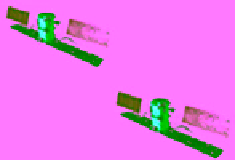Geology Reference
In-Depth Information
Side lobes
Main lobe
R
r
R
t
Radiating
pattern
Figure 7.26
Transmitted radar pulse from a right‐side‐looking air-
borne or space‐borne antenna as it scans a line across the swath.
σ
(Figure 7.26). Radarsat‐1 antenna was right looking and
Radarsat‐2 has the two options of right or left looking.
When the transmitted pulse scans across the swath, it inter-
acts with the ground cover, causing a fraction of the incident
energy to be scattered off the surface. The antenna of the
radar system receives the backscatter, whose power (
P
r
) is
related to the transmitted power (
P
t
) through what is known
as the radar equation [
Ulaby et al
., 1982;
Elachi
, 1988].
The early version of imaging radar systems is the
airborne real aperture radar (RAR). In this system the
backscatter signal from each transmitted pulse is pro-
cessed separately. The spatial resolution across the scan
line (range direction) is usually fine (a few meters from
airborne RAR), but the resolution along the azimuth
direction (normal to the scan line) is very coarse. The fol-
lowing generation of imaging radar, synthetic aperture
radar (SAR), was developed to overcome the drawback
of the coarse azimuth resolution of RAR. The following
text discusses the derivation of the radar equation, which
applies both radar systems, along with the derivation of
the spatial resolution of each system.
Scattering surface
Figure 7.27
Illustration of a radar transmitted pulse, its interac-
tion with a surface, and the backscatter that travels to the
receiving antenna. Parameters used in the “radar equation” are
also shown.
The RHS of the equation is composed of three terms.
The first represents the power distribution of the trans-
mitted signal at distance
R
t
following the antenna pattern.
As shown in the figure, the pattern consists of a main lobe
as well as side lobes. The power intensity is inversely pro-
portional to the square of the distance and is determined
by the antenna gain
G
t
within the pattern. The third term
represents the power of the received backscattering;
A
r
is
the effective aperture of the antenna, and
R
r
is the dis-
tance from the ground target to the antenna. The middle
term,
σ
, represents the effect of the ground target on the
balance of power between the transmitted and received
power. This term has units of area because the first term
is power per unit area and the third term is dimensionless.
Hence, it is called radar cross section. The transmitted
power is intercepted by the “effective receiving area” of
the ground target
A
rs
. When this happens, the target
absorbs a fraction of it, denoted
p
a
. This excites electric
currents on the scattering elements within the target,
which then becomes an antenna re‐radiating with its own
antenna pattern
G
rs
. The re‐radiating power is measured
by the radar cross section. Therefore,
σ
takes the form
Radar Equations and Spatial Resolutions
Figure 7.27
shows the geometry of transmitted and received radar
signals and a few parameters involved in the radar equa-
tion. For convenience of interpretation, the transmitted
and received points are shown at different locations on
the graph, but in all operating SAR they are located at the
same point (i.e., the same antenna). For “point target,”
i.e., a strongly scattering target located against a non scat-
tering background, the radar equation for the received
power usually takes the form
(7.66)
Ap G
a
(
1
)
rs
rs
P
R
G
1
(7.65)
t
P
R
A
This equation presents
σ
as being the area that character-
izes the target in terms of its ability to scatter radar signal.
r
t
r
2
2
4
4
t
r


























































